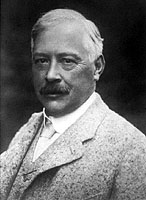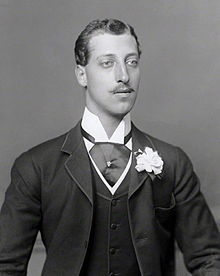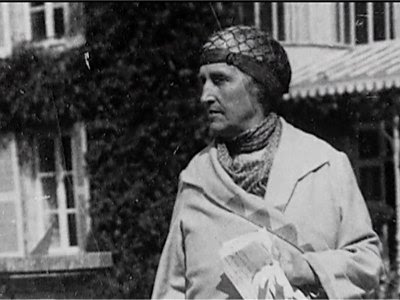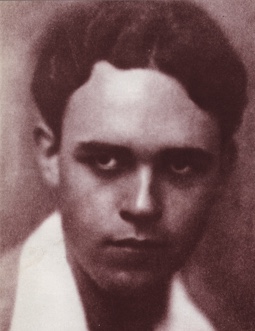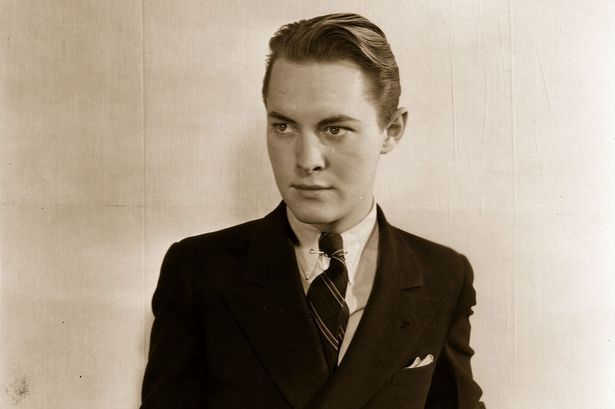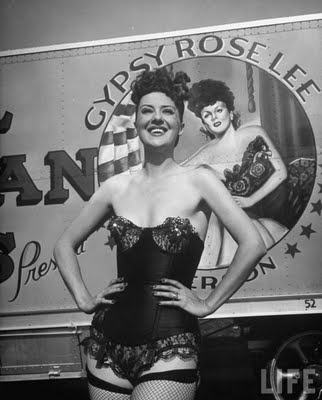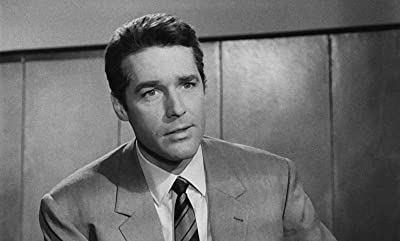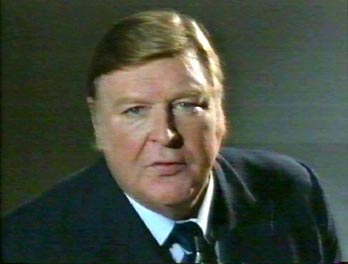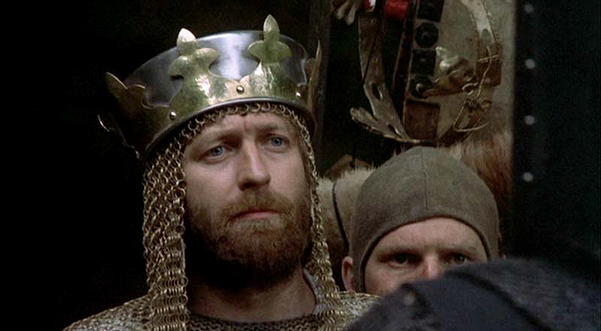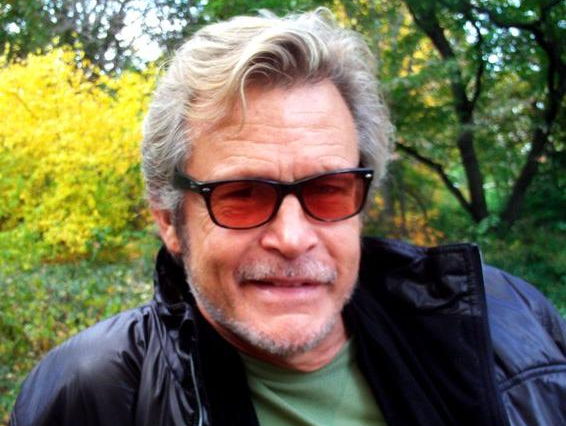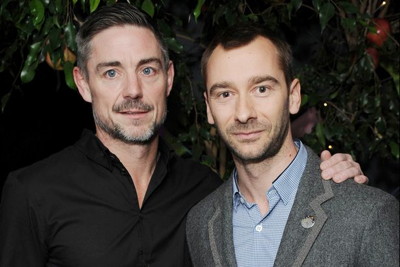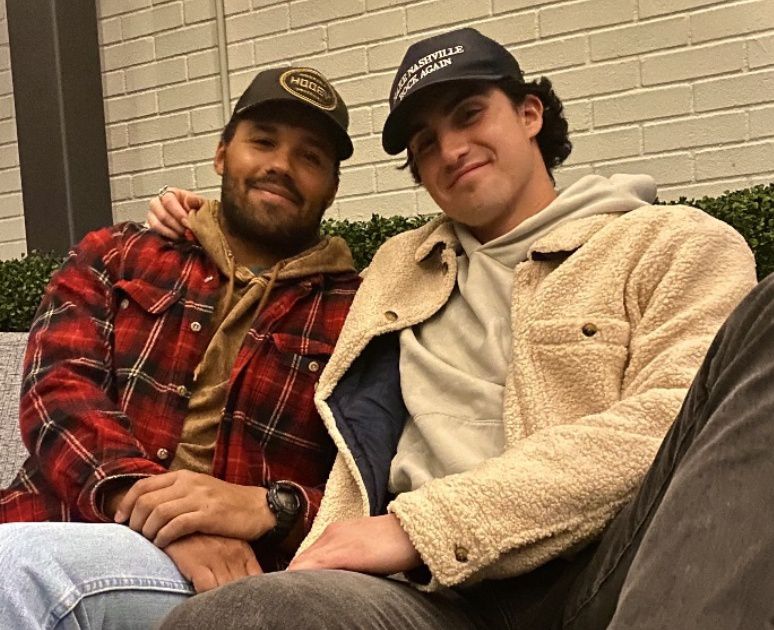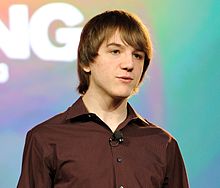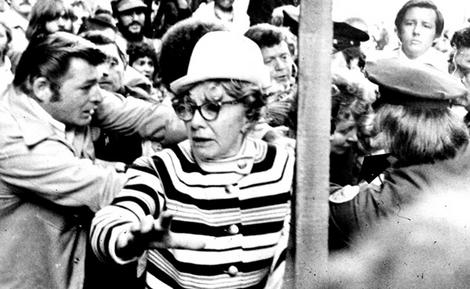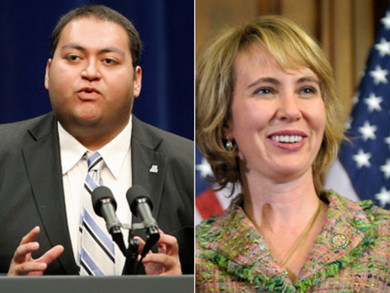|
presents THIS DAY IN GAY HISTORY based on: The White Crane Institute's 'Gay Wisdom', Gay Birthdays, Gay For Today, Famous GLBT, glbt-Gay Encylopedia, Today in Gay History, Wikipedia, and more …
Collected by Ted January 8 [{(o)}]|[{(o)}]|[{(o)}]|[{(o)}]| [{(o)}]|[{(o)}] 1544 – Italy: Cecchino de Bracci, a teenage pupil of Michelangelo (and nephew and lover of Luigi del Riccio) dies. His death inspires Michelangelo to write 48 funeral epigrams.
1860 – The American author and art collector Edward Perry Warren , better known as Ned, was born on this date (d.1928). Independently wealthy, he left his native America and spent most of his life in England with his lover of 50 years, John Marshall, who he had met at Oxford in 1884 and who he called "Puppy." The two set up house together at Lewes House, a large residence in Lewes, East Sussex where they became the centre of a circle of like-minded men interested in art and antiquities. Under the pseudonym "Arthur Lyon Raile," he wrote a three-volume 60,000-word Defence of Uranian Love. He also wrote poetry and novels on the same subject, notably Itamos: A Volume of Poems, and A Tale of Pausanian Love, about homosexuality at Oxford. 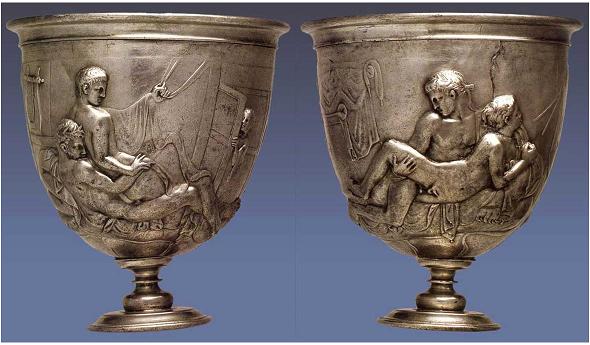 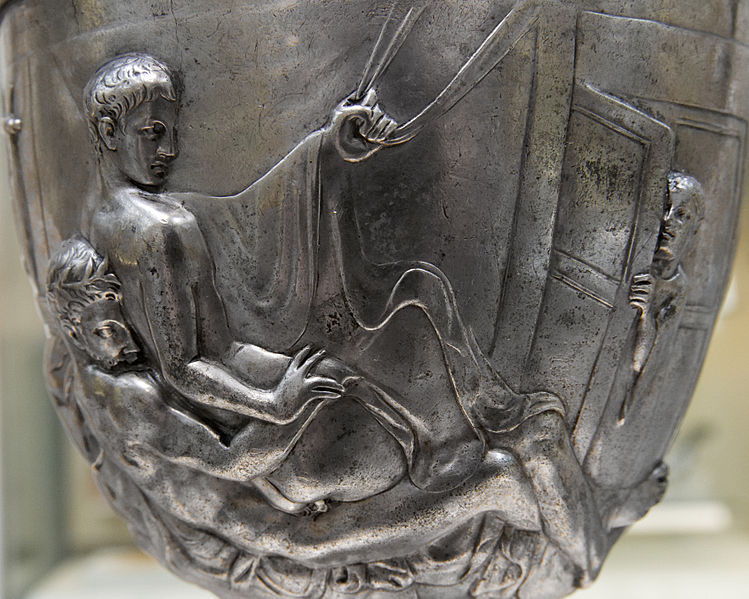 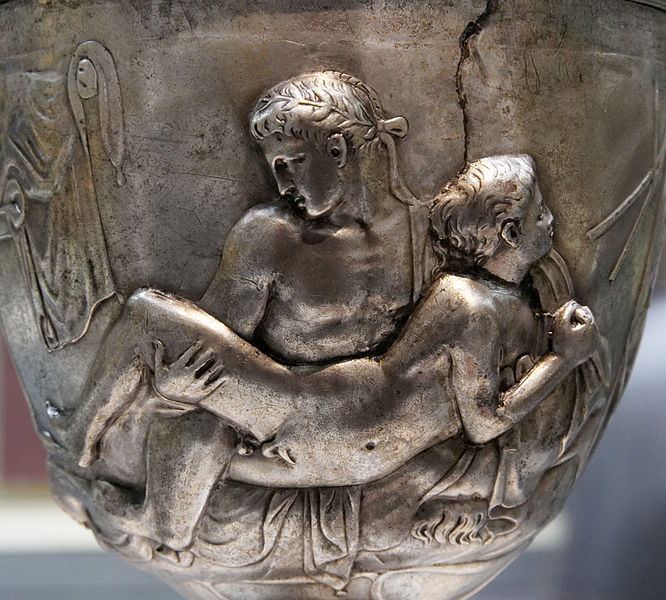 Front and rear views (Click for larger) Warren is perhaps best known today as the purchaser of the Roman silver drinking vessel known as the Warren Cup, which he did not attempt to sell during his lifetime, because of its explicit depiction of homoerotic scenes; both sides show males making love. The front depicts a bearded man having anal sex with a beardless youth while a Peeping Tom looks on; the reverse shows a beardless man having anal sex with a young boy. It is now in the British Museum. The pieces he and Marshall collected during their tours of Italy and Greece later formed the bases of the classical collections of the Boston Museum, where his brother chaired the board of trustees, and the Metropolitan Museum of Art in New York. In 1900 Edward commissioned from Auguste Rodin a version of his "The Kiss", and he particularly specified that the male genitals should be visible and pronounced. Perhaps disappointed that the very heterosexual Rodin had modeled a vague sausage and not the distinct dick required, Warren offered the sculpture as a loan to the Town of Lewes but such a fleshy monument was not considered suitable for public display (it was rejected as "too big and too nude") and it stood in Warren's coach house until his death in 1928. It is now in London's Tate Gallery. Ned and John lived together at Lewes House in East Sussex, for a time with John’s wife, Mary. On February 15, 1928, John retired for the evening, saying that he was not feeling well. Ned gave him a kiss and joined him in bed, but John died during the night. Marshall took his last breath while Ned sat at his bedside. Servants reported that Ned's final words to the dying man were, “Goodbye, Puppy." Warren died less than one year later. Mary, John and Ned were buried in the non-Catholic cemetery in Bagni di Lucca, Italy, a town known as a spa in Etruscan and Roman times.
1864 – Prince Albert Victor, Duke of Clarence and Avondale (Albert Victor Christian Edward); (d.1892), was the eldest son of Albert Edward, Prince of Wales (later King Edward VII), and the grandson of the reigning British monarch, Queen Victoria. From the time of his birth, he was second in the line of succession to the British throne, but never became king: he died before his father and his grandmother, the Queen. Albert Victor was known to his family, and many later biographers, as "Eddy". When young, he travelled the world extensively as a naval cadet, and as an adult he joined the British Army, but did not undertake any active military duties. After two unsuccessful courtships, he was engaged to be married to Princess Mary of Teck in late 1891. A few weeks later, he died during an influenza pandemic. Mary later married his younger brother Prince George, who became King George V in 1910. Albert Victor's intellect, sexuality and mental health have been the subject of much speculation. Rumours linked him with the Cleveland Street scandal, which involved a homosexual brothel, but there is no conclusive evidence verifying or disproving the rumours or his sexual orientation. Some authors have argued that he was the serial killer known as Jack the Ripper, but contemporary documents show that Albert Victor could not have been in London at the time of the murders, and the claim is widely dismissed. In July 1889, the Metropolitan Police uncovered a male brothel operated by Charles Hammond in London's Cleveland Street. Under police interrogation, the male prostitutes and pimps revealed the names of their clients, who included Lord Arthur Somerset, an Extra Equerry to the Prince of Wales. At the time, all homosexual acts between men were illegal, and the clients faced social ostracism, prosecution, and at worst, two years' imprisonment with hard labour. The resultant Cleveland Street scandal implicated other high-ranking figures in British society, and rumours swept upper-class London of the involvement of a member of the royal family, namely Prince Albert Victor. Though none of the male prostitutes in the brothel had ever named Eddy as a client, there was a great deal of talk that seemed to suggest his frequent presence there. It is suggested that Somerset's solicitor, Arthur Newton, fabricated and spread the rumours to take the heat off his client. Letters exchanged between the Treasury Solicitor, Sir Augustus Stephenson, and his assistant, Hamilton Cuffe, make coded reference to Newton's threats to implicate Albert Victor. The Prince of Wales intervened in the investigation; no clients were ever prosecuted and nothing against Albert Victor was proven. Although there is no conclusive evidence for or against his involvement, or that he ever visited a homosexual club or brothel, the rumours and cover-up have led some biographers to speculate that he did visit Cleveland Street, and that he was "possibly bisexual, probably homosexual". This is contested by other commentators, one of whom refers to him as "ardently heterosexual" and his involvement in the rumours as "somewhat unfair".
1865 – Winnaretta Singer, Princesse Edmond de Polignac (d.1943) was a musical patron and heir to the Singer sewing machine fortune. Born in America, she lived most of her adult life in France. Winnaretta Singer was the twentieth of the 24 children of Isaac Singer. Her mother was his Parisian-born second wife, Isabella Eugenie Boyer, who was possibly the model for Bartholdi's Statue of Liberty. Winnaretta was born in Yonkers, New York. After the American Civil War, the Singer family moved to Paris, where they remained until the Franco-Prussian War. The family then settled in England, first in London, and then to Paignton, Devon where they moved to Oldway Mansion a 115-room palace built by her father. After Isaac Singer's death in 1875, Isabelle and her children moved back to Paris. Although known within private social circles to be lesbian, Winnaretta married at the age of 22 to Prince Louis de Scey-Montbéliard. The marriage was annulled in 1892 by the Catholic church, five years after a wedding night that reportedly included the bride's climbing atop an armoire and threatening to kill the groom if he came near her. In 1893, at the age of 29, she stepped companionably into an equally chaste marriage with the 59-year-old Prince Edmond de Polignac (1834-1901), a gay amateur composer. Although it was a mariage blanc (unconsummated marriage), or indeed a lavender marriage (a union between a gay man and a lesbian), it was based on profound love, mutual respect, understanding, and artistic friendship, expressed especially through their love of music. She had affairs with numerous women, never making attempts to conceal them, and never going for any great length of time without a female lover. She had these affairs during her own marriages and afterwards, and often with other married women. The affronted husband of one of her lovers once stood outside the princess's Venetian palazzo, declaring, "If you are half the man I think you are, you will come out here and fight me." Polignac had a relationship with painter Romaine Brooks, which had begun in 1905, and which effectively ended her affair with Olga de Meyer, who was married at the time and whose godfather (and purported biological father) was Edward VII. Composer and conductor Ethel Smyth fell deeply in love with her during their affair. In the early 1920s Polignac became involved with pianist Renata Borgatti. From 1923 to 1933 her partner was the British socialite and novelist Violet Trefusis, with whom she had a loving but often turbulent relationship. Alvilde Chaplin, future wife of the author James Lees-Milne, was involved with Singer from 1938 to 1943; the two women were living together in London at the time of Winnaretta's death.
1901 – Forman Brown (d.1996) was one of the world's leaders in puppet theatre in his day, as well as an important early gay novelist. He was a member of the Yale Puppeteers and the driving force behind Turnabout Theatre. He was born in Otsego, Michigan, in 1901 and died in 1996, two days after his 95th birthday. Brown briefly taught at North Carolina State College, followed by an extensive tour of Europe. Forman's Yale Puppeteers, which he established upon graduating from University of Michigan (class of 1922), opened a puppet theatre in Los Angeles in 1941 (the Turnabout Theater) that attracted celebrity attention and support from some of Hollywood's biggest names, e.g., Greta Garbo, Marie Dressler, and Douglas Fairbanks, as well as other notable figures including Albert Einstein. Brown wrote all the songs and sketches for the troupe's productions. Regular performers included Elsa Lanchester and Odetta. Bette Midler sang one of Forman's songs, Mrs. Pettibone, at a Los Angeles AIDS benefit. Along with Yale Puppeteers Harry Burnett and Richard Brandon (Brown's lifelong lover), Brown launched Turnabout Theatre in 1941 as "a vehicle for performing both puppet plays and revues for adults." Turnabout Theatre was a highly popular puppetry venue until its dissolution in 1956. Reversible seats were installed in the theatre so that after the puppet shows were performed at one end of the auditorium, the puppeteers asked the audience to "turnabout" their seats for the Turnabout revue staged at the opposite end of the auditorium. 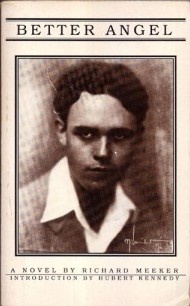 In 1933, he wrote Better Angel, under the pseudonym Richard Meeker, about a young man coming to terms with his homosexuality. The novel is regarded as "the first American novel to present the 'gay' experience in a healthy light."
1910 – (Richard) Dick Cromwell was an American actor, born LeRoy Melvin Radabaugh (d.1960). His family and friends called him Roy, though he was also professionally known and signed autographs as Dick Cromwell. Cromwell was best known for his work in Jezebel (1938) with Bette Davis and Henry Fonda and in The Lives of a Bengal Lancer (1935) where he shared top billing with Gary Cooper and Franchot Tone. The Lives of a Bengal Lancer earned Paramount Studios a nomination for Best Picture in 1935, though Mutiny on the Bounty instead took the top award at the Oscars that year. Cromwell was born in Long Beach, California. While helping his young widowed mother to support the family with odd-jobs, Cromwell enrolled as a teenager in the Chouinard Art Institute in Los Angeles on a scholarship. As Cromwell developed his talents for lifelike mask-making and oil-painting, he curried friendships in the late 1920s with various then-starlets who posed for him and collected his works including Tallulah Bankhead, Joan Crawford, Greta Garbo, Claire Dubrey, Ann Sothern, and even Marie Dressler (whom he would later share top-billing with in 1932's Emma). Other patrons of Cromwell's life masks included Broadway actresses Lilyan Tashman, Katharine Cornell, and Beatrice Lillie. The young Roy Radabaugh, as he was then known, had dabbled in film extra work on the side. On a whim, friends encouraged Roy to audition in 1930 for the remake of the Richard Barthelmess silent: Tol'able David (1930). Radabaugh won the role over thousands of hopefuls, and in storybook fashion, Harry Cohn gave him his screen name and launched his career. Later, Cohn signed Cromwell to a multi-year contract based on the strength of his performance and success in his first venture at the box-office. Cromwell appeared in a number of now mostly forgotten movies throughout the 1930s, aside from the aforementioned standout roles. Cromwell did another notable turn as defendant Matt Clay to Henry Fonda's title-performance in Young Mr. Lincoln (1939). He also made occasional appearances on stage. During the freewheeling heydey of West LA nightlife in the late 30s, Cromwell is said by author Charles Higham to have carried on a sometime, though obviously very discreet, affair with aviator and businessman Howard Hughes. Cromwell served admirably during the last two years of World War II with the United States Coast Guard, alongside fellow actor and enlistee Cesar Romero. During this period, popular composer/lyricist Cole Porter rented Cromwell's home in the Hollywood Hills, where Porter worked at length on Panama Hattie. Director James Whale was a personal friend, for whom Cromwell had starred in The Road Back (1937), the ill-fated sequel to All Quiet on the Western Front. With the war's end, and upon returning to California from the Pacific after nearly three years of service with the Coast Guard, Cromwell continued his foray into acting in local theatre productions and Summer Stock in the East. Cromwell was a fixture on the Hollywood social scene. Like many young, good-looking male screen favorites of the era, Cromwell experimented with the gay lifestyle. According to the book Cut! Hollywood Murders, Accidents and Other Tragedies, Cromwell was a regular at George Cukor's notorious 'boys nights'. Whatever his true sexual preference, Cromwell felt compelled to settle down for awhile, at least publically, and he got married. Cromwell was married once, briefly from 1945-1946, to the British-born actress Angela Lansbury, when she was 19 and Cromwell was 35. It was nearly 50 years before Lansbury would candidly discuss her first marriage to Cromwell, and its demise due to Cromwell's bisexuality (though other sources list him as being gay). Cromwell's break from films due to his stint in the Service meant that he was not much in demand after the War's end. Cromwell finally retired from films after his comeback fizzled: his last role was in a noir flick of 1948, entitled Bungalow 13. All told, Cromwell's film career spanned 39 films. In the 1950s, Cromwell went back to his given name and studied ceramics. He built a pottery studio at his home. There, Radabaugh successfully designed coveted decorative tiles for himself and for his industry-friends. Radabaugh's original tiles as well as his large decorative art deco-style wall paintings of Adam and Eve can still be seen today in the mezzanine off the balcony of the restored Pantages Theatre in Hollywood, which is today considered a noted architectural landmark. In July of 1960, Cromwell planned another comeback of sorts. Unfortunately, he fell ill and he died on October 11, 1960 in Hollywood of complications from liver cancer. He was just 50 years old.
1911 – Gypsy Rose Lee (d.1970) was an American burlesque entertainer famous for her striptease act. She was also an actress, authoress, and playwright whose 1957 memoir was made into the stage musical and film Gypsy. Rose Louise Hovick, better known as Gypsy Rose Lee was born in Seattle, Washington, although her mother, Mama Rose, later shaved three years off both of her daughters' ages. She was initially known by her middle name, Louise. Mama Rose was a teenaged bride fresh from a convent school when she married John Olaf Hovick, who was a newspaper advertising salesman and a reporter at The Seattle Times. Louise's sister, Ellen Evangeline Hovick (later better known as actress June Havoc), was born in 1913. After their parents divorced, the girls supported the family by appearing as a sister act in Vaudeville, where June's talent shone while Louise remained in the background. At the age of 15 in December 1928, June eloped with a dancer in the act, much to her mother's displeasure, going on to a brief career in marathon dancing, which was more profitable than tap dancing at the time. Louise's singing and dancing talents were insufficient to sustain the act without June. Eventually, it became apparent that Louise could make money in burlesque, which earned her legendary status as a classy and witty strip tease artist. Initially, her act was propelled forward when a shoulder strap on one of her gowns gave way, causing her dress to fall to her feet despite her efforts to cover herself; encouraged by the audience response, she went on to make the trick the focus of her performance. Her innovations were an almost casual strip style, compared to the herky-jerky styles of most burlesque strippers (she emphasized the "tease" in "striptease") and she brought a sharp sense of humor into her act as well. She became as famous for her onstage wit as for her strip style, and—changing her stage name to Gypsy Rose Lee—she became one of the biggest stars of Minsky's Burlesque, where she performed for four years and was frequently arrested in raids on the Minsky brothers' shows. In 1937 and 1938, billed as Louise Hovick, she made 5 films in Hollywood. But her acting was generally panned, so she returned to New York City where she had an affair with film producer Michael Todd and co-produced and appeared in his 1942 musical revue "Star and Garter".Trying to describe what Gypsy was (a "high-class" stripper), H. L. Mencken coined the term ecdysiast. Her style of intellectual recitation while stripping was spoofed in the number "Zip!" from Rodgers and Hart's Pal Joey, a play in which her sister June appeared. Gypsy can be seen performing an abbreviated version of her act (intellectual recitation and all) in the 1943 film Stage Door Canteen. In 1941, Gypsy Rose Lee authored a mystery thriller called The G-String Murders, which was made into the 1943 film Lady of Burlesque starring Barbara Stanwyck. Lee's second murder mystery, Mother Finds a Body, was published in 1942. While she worked at Minsky's, Gypsy Rose Lee had relationships with an assortment of men. In Hollywood, she married Arnold "Bob" Mizzy in 1937, at the insistence of the film studio. Gypsy was at one time in love with Michael Todd and in 1942, in an attempt to make him jealous, she married William Alexander Kirkland. They divorced in 1944. While married to Kirkland, she gave birth on December 11, 1944 to a son fathered by Otto Preminger. She named him Erik Lee and he has has been known successively as Erik Kirkland, Erik de Diego and Erik Preminger. Gypsy Lee was married for a third time in 1948, but eventually divorced. Both Gypsy Rose and Mama Rose were avidly bisexual, with Mama Rose tending more to being Lesbian. Gypsy and sister June Havoc continued to get demands for money from their mother, who had opened a boardinghouse for Lesbians in a 10-room apartment on West End Avenue in New York City (the property rented for her by Gypsy). Rose shot and killed one of her guests (Rose's female lover who had made a pass at Gypsy, according to an account provided by Gypsy's son, Erik). The incident was explained away as a suicide and Rose was not prosecuted. Mother Rose died in 1954. But one of the most intersting periods in Gypsy's life, from our perspective, was her involvement in February House:
 February House was an extraordinary experiment in communal living, one involving young but already iconic writers — and the country's best-known burlesque performer — in a house at 7 Middagh Street in Brooklyn from June 1940 ato December 1941. It was a fevered yearlong party fueled by the appetites of youth and by the shared sense of urgency to take action as artists in the months before America entered the war. This improbable ménage was the brainchild of George Davis, a gay man about town and former fiction editor at Harper's Bazaar who had published Jean Cocteau, Colette, John Cheever, Dawn Powell and Gertrude Stein. Out of a job and homesick for the larky, creative family life he had enjoyed with his authors and colleagues, he invited two of his proteges to come live with him: his most recent discovery, Carson McCullers, the waiflike but hard-drinking Southern prodigy who was trying unsuccessfully to get traction on her second novel, and W. H. Auden, who was on the lam from the European war and, as he wrote to a friend, ''VERY VERY VERY poor.'' Following hard on their heels was Auden's college-student lover, Chester Kallman, of whom Davis would say to a stevedore friend from the Brooklyn docks: ''Don't scare Chester. He's very delicate.'' There also was Benjamin Britten, who was trying to write an opera with Auden about Paul Bunyan, and his lover, the tenor Peter Pears. Salvador Dali, Lincoln Kirstein, Leonard Bernstein and George Balanchine were among the later gayer satellites. Then there was Gypsy Rose Lee, stripper, culture vulture and darling of the glitterati, who had moved to Brooklyn so Davis could help her with a thriller she was writing, ''The G-String Murders.''February House was given its name by Anaïs Nin, who noted that several of the residents had their birthdays during that month. With such a cast of characters, matters didn't always run smoothly at 7 Middagh Street. The principal cause of friction was Auden, who turned out to be a neat-freak horrified by the household's general disorder and by McCullers's impressionistic cooking (a specialty was ''Spuds Carson,'' mashed potatoes incorporating whatever else was in the house). Appointing himself major-domo, he issued chore lists, meal schedules and budgets, not to mention rules for dinner-table conversation, occasionally to the others' dismay. Although he became a mentor to Jane Bowles as she struggled with her novel, ''Two Serious Ladies,'' Auden and the dandified Paul rubbed each other the wrong way; certainly he was not amused by the noisy sex games the Bowleses indulged in — including one in which they chased each other around the bedroom, with Jane shouting ''I'll get you for this. You've ruined my uterus.'' And his equanimity wasn't helped by the discovery that Kallman had been carrying on an affair with a young British sailor, an infidelity that so devastated Auden that one evening he tried (unsuccessfully) to strangle his lover while he slept. Some differences between the residents proved to be creative, however — most notably in the case of the voluptuous, wisecracking Gypsy Rose and the perversely childlike McCullers who, for a time, become lovers. Curled up with a whiskey in Gypsy Rose's room, McCullers would listen to her new friend's vaudeville stories, or pour out her own troubles, enjoying ''a family feeling that was dear to me.'' The feeling ripened into an epiphany one winter night when she and Lee were crazily chasing a fire engine down Middagh Street; catching Gypsy Rose's arm, she panted, ''Frankie is in love with her brother and his bride and wants to become a member of the wedding!'' Although ''Gypsy looked at me as though I'd gone insane,'' McCullers recalled, it was a breakthrough moment, enabling her to complete ''The Member of the Wedding.'' Other influences made their brief year at Middagh Street a formative time for the artists who lived there. Auden, in particular, found material for his depiction of angst-haunted singles in ''The Age of Anxiety'' and worked through the crisis of love and faith that would fuel his great oratorio ''For the Time Being.'' Britten realized that America was the wrong soil to nourish his creative genius, and returned to England, where he would shortly produce his own breakthrough, ''Peter Grimes.'' Jane Bowles finished ''Two Serious Ladies,'' and McCullers encountered, in a bar on Sands Street, the hulking Amazon and hunchbacked midget who would become the main characters of ''The Ballad of the Sad Cafe.'' At the end of 1942, the tenants went their own ways, leaving this fantastic run-down house in Brooklyn Heights which was later demolished to make way for the Brooklyn-Queens Expressway. Its story has been preserved by Sherrill Higgins in her book February House.
1926 – Kerwin Mathews (d.2007) was a virile, dashing actor who will be remembered for his portrayals of such fantasy heroes as Gulliver and Jack the Giant Killer, and in particular for his performance in The Seventh Voyage of Sinbad (1958), which has achieved cult status due to its thrilling score by Bernard Herrmann and the sensational stop-motion effects achieved by the master animator Ray Harryhausen. The climactic battle between Mathews as Sinbad and a sword-fighting skeleton has become one of the iconic sequences in fantasy cinema. Born in Seattle in 1926, Mathews was raised by his mother in Wisconsin, after his parents' marriage broke up. At Beloit College, Wisconsin, which was noted for its drama programme, he shone at acting, but after graduation he spent several years teaching English before moving to Hollywood, encouraged by friends who told him he had the looks and talent to succeed in motion pictures. While appearing at the Pasadena Playhouse, Mathews was spotted by an agent, who arranged for him to meet Harry Cohn, head of Columbia Pictures. He made his screen début in the tense thriller Five Against the House (1955), as one of five students who plan a casino robbery for fun, but are then persuaded to carry it out. Guy Madison and Kim Novak were top-billed. His impressive showing won him a starring role in The Garment Jungle (1957). His most famous role was in The Seventh Voyage of Sinbad, as the intrepid adventurer seeking the egg of a roc (a giant two-headed bird) that will restore his miniaturised sweetheart. It was ultimately hailed as one of the best fantasy films since King Kong. It was one of the top moneymakers of 1958, and made another $6m when reissued in 1968. He returned to fantasy with another collaboration with Harryhausen and Herrmann, The Three Worlds of Gulliver (1960), a pleasing diversion, though it diluted some of Swift's satire by concentrating on the Brobdingnagians and Lilliputians, and adding a romantic partner for Gulliver. During this period, the height of his fame, Mathews rarely gave interviews, possibly because he did not want to talk about his private life, for it was a time when action heroes could not admit to being gay. In 1961 he met Tom Nicoll, a British display manager for Harvey Nichols, who was to be his life partner for the next 46 years until his death. The same year, Mathews played a missionary in The Devil at 4 O'Clock, a tale of rescue work during a volcanic eruption that proved heavy going, despite a cast headed by Spencer Tracy and Frank Sinatra. For the next few years, Mathews worked mainly in Europe or on television. His last feature film was the horror spoof Nightmare in Blood (1976), in which a horror star attending a convention turns out to be a real vampire. In 1978 he retired from acting and moved to San Francisco, where he became an antique dealer. In latter years he enjoyed answering fan mail, which arrived consistently, and he attended film conventions. 'I have absolutely no regrets about my acting career,' he said. 'On balance, I think it was certainly worthwhile for me to have temporarily left the real world and become an actor.' He died in San Francisco on July 5, 2007 at the age of 81.
1927 – Daniel Farson (d.1997) was a British writer and broadcaster, strongly identified with the early days of commercial television in the UK, when his sharp, investigative style contrasted with the BBC's more deferential culture. Sensitive about his homosexuality, Farson was well-placed to make programmes about people outside the mainstream, and this lent an extra edge to his social commentaries about a fast-changing Britain. Farson was a prolific biographer and autobiographer, chronicling the bohemian life of Soho and his own experiences of running a music-hall pub on London's Isle of Dogs. His memoirs were titled Never a Normal Man. Born in Kensington, London, the son of American journalist Negley Farson, his childhood was mostly divided between Britain and North America. He visited Germany with his father while Negley was reporting on the Nazi regime, and was patted on the head by Adolf Hitler, who described him as a "good Aryan boy". He briefly attended the British public school Wellington College, whose militaristic regime was not to his taste; Farson had become intensely aware of his homosexuality, which would sporadically cause him great emotional strain. As a teenager he worked as a parliamentary correspondent, and was pursued in the House of Commons by the predatory Labour Member of Parliament Tom Driberg. Farson shot to fame in the 1950s when he joined Associated-Rediffusion, the first commercial television company to operate in Britain. Here he took risks that few television interviewers (certainly not those employed at the still very conservative BBC) would dare to take at the time. In his series Out of Step (1957) and People in Trouble (1958) he dealt with issues of social exclusion and alienation that most of the media at the time preferred to sweep under the carpet (in this he was helped, of course, by the fact that as a gay man - a term he would not himself use even when it came to be much preferred to "homosexual"). A regular guest on Farson's programmes at this stage was James Wentworth Day, a reactionary British writer of the Agrarian Right. However, Wentworth Day's appearances would rapidly come to an end when he claimed that all homosexuals should be hanged. Farson insisted that the episode of People in Trouble in which Wentworth Day had made those remarks - concerning transvestism - was scrapped before it had been completed. He publicly insisted that the Independent Television Authority would ban it; in reality Farson was terrified that Wentworth Day would attempt to bring him to trial - a trial which would inevitably have been a high-profile event comparable to that of Oscar Wilde. After this, Farson immediately froze Wentworth Day out of his life and his programmes. In 1962, Farson made a documentary for Associated-Rediffusion about pub entertainment in the East End of London where he lived, called Time Gentlemen Please. Soon after this he bought a pub, The Waterman's Arms, in the East End with the explicit intent of reviving old-time music hall, but this failed and the money he lost would have bought a row of houses at the time (1963). By the end of 1964 he had resigned from Associated-Rediffusion) and would keep a lower public profile for the rest of his life. He moved from London to live in his parents' house in Devon, but continued to visit the pubs and drinking clubs of London's Soho on a regular basis. He wrote a number of studies of artists and authors. The Man Who Wrote Dracula (1975) was a life of his grand-uncle, Bram Stoker. Farson also wrote the authorized biography of his friend, the painter Francis Bacon (The Gilded Gutter Life of Francis Bacon (1994) - at Bacon's insistence this was not published until after the artist's death). The 1998 film Love Is the Devil: Study for a Portrait of Francis Bacon starring Derek Jacobi and Daniel Craig draws heavily on the book, showing Farson (played by Adrian Scarborough) socialising with Bacon, as well as interviewing him on television. The film is dedicated to him. His last book was a "portrait" of the artists Gilbert and George, published posthumously in 1999 His father had been an alcoholic, and Farson himself had been a heavy drinker since his Bohemian days in Soho in the 1950s. In later years, the effects of alcoholism became more apparent. He knew he was dying of cancer in March 1997, when his self-deprecating autobiography, Never A Normal Man. He died at his father's house in Devon on 27 November 1997.
1941 – Graham Chapman, English comedian, actor, writer, physician and one of the six members of the Monty Python comedy troupe. (d.1989) He was also the lead actor in their two narrative films, playing King Arthur in Monty Python and the Holy Grail and the title character in Monty Python's Life of Brian. Chapman kept his sexuality secret until the mid 1970s when he famously came out on a chat show hosted by British jazz musician George Melly, thus becoming one of the first celebrities to do so. Several days later, he came out to a group of friends at a party held at his home in Belsize Park where he officially introduced them to his partner, David Sherlock, whom he had met in Ibiza in 1966, and subsequently raised their son, John Tomiczek, together. After Chapman made his sexuality public, a member of the television audience wrote to the Pythons to complain that she had heard a member of the team was Gay, and included in the letter a Biblical passage calling for all homosexuals to be stoned to death. Already aware of his sexual orientation, Eric Idle replied, "We've found out who he was and we've taken him out and stoned him." Chapman was a vocal spokesman for Gay rights, and in 1972 he lent his support to the fledgling newspaper Gay News, which publicly acknowledged his financial and editorial support by listing him as one of its `special friends.' Among Chapman's closest friends were Keith Moon of The Who, singer Harry Nilsson, and Beatle Ringo Starr. Asteroid 9617 Grahamchapman, named in Chapman's honor, is the first in a series of six asteroids carrying the names of members of the Monty Python comedy troupe. A memorial service was held for Chapman in December 1989 in the Great Hall at St. Bartholomew's. John Cleese delivered the eulogy; after his initial remarks, he said of his former colleague "... good riddance to him, the freeloading bastard, I hope he fries!", and then pointed out that Chapman would have been disappointed if Cleese passed on the opportunity to scandalize the audience. He explained that Chapman would have been offended had Cleese, the first person to say "shit" on British television, not used Chapman's own funeral as an opportunity to also become the first person at a British memorial service to use the word "fuck". Afterward, Cleese joined Gilliam, Jones, and Palin along with Chapman's other friends as Idle led them in a rendition of "Always look on the Bright Side of Life" from the film Monty Python's Life of Brian. On December 31, 1999 Chapman's ashes were rumored to have been "blasted into the skies in a rocket.", though in actual fact, Sherlock scattered Chapman's ashes on Snowdon, North Wales on June 18, 2005.
1942 – George Passmore is an English artist and is the George in Gilbert and George. George was born in Plymouth in the United Kingdom, and first studied art at the Dartington Hall College of Art and the Oxford School of Art, then part of the Oxford College of Technology. George first met Gilbert Proesch on 25th September 1967 while studying sculpture at St Martins School of Art, London. The two claim they came together because George was the only person who could understand Gilbert's rather poor spoken English. In a 2002 interview with the Daily Telegraph they said of their meeting: 'it was love at first sight'. It ihas always been widely assumed that Gilbert & George are lovers, although they always dismiss questions about their sex lives. They were initially known as performance artists. While still students they made The Singing Sculpture (1970), for which they covered themselves in gold metallic paint, stood on a table, and mimed to a recording of Flanagan and Allen's song Underneath the Arches, sometimes for hours at a time. A number of works from the early 1970s consisted of the two of them getting drunk, usually on gin. Smashed (1973) was a set of photographs documenting a drunken evening, while Gordon's Makes Us Drunk is a film of the pair drinking Gordon's gin and listening to Elgar and Grieg, occasionally saying 'Gordon's makes us very drunk' or a slight variant thereof. This work, in common with many others by Gilbert and George, is executed in a completely deadpan way. The matching business suits which they wore for these performances became a sort of uniform for them, and they rarely appear in public unless wearing them. It is also virtually unheard of for one of the pair to be seen without the other. They refuse to disassociate their performances from their everyday lives, insisting that everything they do is art. The pair regard themselves as 'living sculptures'. The pair are perhaps best known for their large scale photo-montages, such as Cosmological Pictures (1993), frequently tinted in extremely bright colours, backlit, and overlaid with black grids so as to resemble stained glass windows. Gilbert & George themselves often feature in these works, along with flowers and youths, their friends, and echoes of Christian symbolism. The early works in this style were in black and white, with red and yellow touches in later series. Later these works moved to use a range of bold colours. Their 2005 work, Sonofagod, has returned to a more sombre and darker palette. 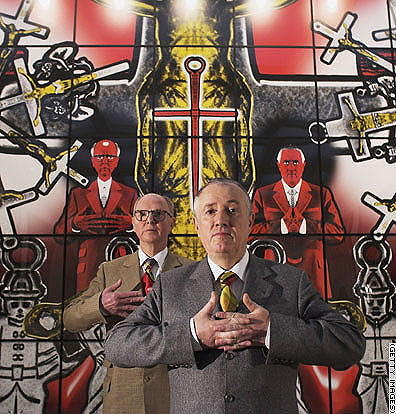 Some series of their pictures have attracted media attention through including potentially shocking imagery, including nudity, depictions of sexual acts, and bodily fluids, such as faeces, urine and semen. The titling of their series, such as 'Naked Shit Pictures' (1995), has also contributed to media attention. In 1986 Gilbert and George attracted criticism from left-wing commentators for a series of works seemingly glamorising 'rough types' of London's East End such as skinheads, while a picture of an Asian man bore the derogatory title 'Paki'. They have now settled the question of their relationship. In 2009, Goerge confirmed: "We got married last year at Bow register office. We thought it was probably about time." Yi Gangyu and Keith, their two staff, acted as witnesses. They celebrated afterwards at an Indian restaurant close to their Spitalfields residence. The notoriously private duo had previously denied their intention to marry, with George saying, "We prefer to live in sin. We are the ideal feminist couple. We have equality in our relationship," when questioned on the subject soon after the Civil Partnership Act came to fruition.
1947 – David Bowie (d.2016), also known as "The Dame," became a leading light in 1970s "glam rock," going on to enjoy international superstar status. Bowie's career had a longevity matched only by such grand old men as the Rolling Stones, and his status as media icon is unmatched by any of his contemporaries. His fiftieth birthday was celebrated to international press and media interest; and in 2000 the BBC released a remastered CD of early studio sessions, which had acquired archival status. In the same year he headlined the equally iconic Glastonbury music festival, taking easy precedence over a younger generation of musicians. Bowie was born David Robert Jones in the Brixton section of London, the son of a working class family that soon moved to Kent, where he grew up. A fan of Little Richard and jazz, Bowie began playing music at age 12, when his parents bought him a saxophone. He performed in a series of small-time groups while in high school. In 1965 he adopted the name David Bowie to avoid confusion with actor Davy Jones, who later became the "singer" for the made-for-TV band The Monkees. Bowie's significance for queer culture is deeply contradictory, since his claims to be gay or bisexual were almost certainly never anything other than a publicity-seeking gambit. As a performer Bowie adopted a seemingly endless string of personae, from Major Tom to Ziggy Stardust and the Thin White Duke, and his theatrical stage presence owed much to early collaboration with gay mime artist Lindsay Kemp. Wearing elements of drag and heavy makeup was an intrinsic part of this theatricality, rather than the expression of any inner queerness. It seems to have been Bowie's then manager, Ken Pitt, who decided to play the gay card. He arranged for Jeremy, the only gay publication in Britain at the time, to publish an article about Bowie in January 1970. This was followed in 1972 by an interview for Melody Maker in which the singer stated, "Yes, of course I'm gay, and always have been." In a 1976 Playboy interview he declared himself bisexual, rather than gay. Such published statements were combined with such on-stage antics as mock-fellating guitarist Mick Ronson and some very public homoerotic partying with Mick Jagger, Lou Reed, and Iggy Pop. But Bowie's appropriation of a gay persona always existed alongside explicit warnings from the star himself that nothing he said was to be believed. In 1971 he cautioned, "My songwriting is certainly not an accurate picture of how I think at all." This is just as well since close analysis of Bowie's "gay" lyrics reveals little gay pride. Lady Stardust sings, "songs of darkness and disgrace"; the gay seducer in "The Width of a Circle" has a "tongue swollen with devil's love," and after he "smelt the burning pit of fear" (you don't need to be Freud to spot an anal metaphor here!), the protagonist knows he will never "go down to the Gods again." Admittedly, however, many listeners have found Bowie's most overly gay song, "John, I'm Only Dancing," reassuring and positive. The song in effect says that it is okay to be whoever you are sexually. Biographer David Buckley's view of the period is that Bowie, "a taboo-breaker and a dabbler ... mined sexual intrigue for its ability to shock", and that "it is probably true that Bowie was never gay, nor even consistently actively bisexual ... he did, from time to time, experiment, even if only out of a sense of curiosity and a genuine allegiance with the 'transgressional'." Biographer Christopher Sandford says that according to Mary Finnigan, with whom Bowie had an affair in 1969, the singer and his first wife Angie "lived in a fantasy world ... and they created their bisexual fantasy." Sandford tells how, during the marriage, Bowie "made a positive fetish of repeating the quip that he and his wife had met while 'fucking the same bloke' ... Gay sex was always an anecdotal and laughing matter. That Bowie's actual tastes swung the other way is clear from even a partial tally of his affairs with women." After his death in 2016, many of his songs reached a new status on Billboard's hit lists, setting new records.
1950 – Michael Kearns is an American actor, writer, director, teacher, producer, and activist. He is noted for being one of the first openly gay actors, and after an announcement on Entertainment Tonight in 1991, the first openly HIV-positive actor in Hollywood. Kearns was born in St. Louis, Missouri. As a young man he attended the Goodman School of Drama in Chicago, Illinois, and graduated in 1972 and moved to Los Angeles. For more than 25 years he has been active in the Los Angeles art and politics communities, maintaining a mainstream film and television career with a prolific career in the theatre. His activism is deeply integrated into his theatre works, and he has received grants from the City of Los Angeles Cultural Affairs Department, the Brody Foundation, and PEN Center USA West. In 1984, along with playwright James Carroll Pickett, he co-founded Artists Confronting Aids (ACA), and is a current commissioner of Parents, Families and Friends of Lesbians and Gays (PFLAG). Long before coming out of the closet was considered a career move in the entertainment industry, Kearns was the first Hollywood actor on record to come out in the mid-seventies, amidst a shocking amount of homophobia. He subsequently made television history in 1991 by announcing on Entertainment Tonight that he was HIV positive, and then in 1992, as an openly HIV-impacted actor, guesting on a segment of ABC TV's Life Goes On in which he played a character who had the virus. He played Cleve Jones in the HBO adaptation of Randy Shilts' And the Band Played On, appeared in A Mother's Prayer, It's My Party and had a recurring role on Beverly Hills, 90210, a variety of shows that depicted HIV/AIDS. Kearns is a regular contributor to a number of magazines and newspapers, including the Frontiers, Los Angeles Times, L.A. Parent, IN Magazine, and L.A. Weekly. He is also author of five theatre books: T-Cells & Sympathy, Acting = Life, The Solo Performer's Journey, Getting Your Solo Act Together, and Life Expectancies. Both T-Cells & Sympathy and Acting = Life were nominated for Lambda Literary Awards. In 1995, Kearns began proceedings that resulted in his adoption in 1997 of a child. In a March 2013 appearance on The Howard Stern Show on Sirius XM Radio, Kearns admitted to affairs with actor Rock Hudson and Barry Manilow. He presently lives in Los Angeles with his daughter who was born in 1994.
1973 – Charlie Condou is an actor and writer best known for playing gay sonographer, Marcus Dent, in the long-running TV series, Coronation Street. He joined Coronation Street in 2007, but left it in 2008. Speaking of his departure Condou said: "I have had a fantastic time in Coronation Street, but as a jobbing actor I believe it is time to move on." In March 2011 he returned to Coronation Street after an absence of almost three years. He had been promised that Marcus will become a leading character on the show following reports that Coronation Street was to have its first gay wedding in 2011 when Marcus Dent tied the knot with former flame Sean Tully. However the plot failed to materialise reflecting his growing unease with his on-screen pairing with Sean Tully, played by Antony Cotton. Coronation Street sources initially indicated that he would enjoy a much more prominent role in the show, possibly at the expense of Cotton He is a supporter of Manchester Pride, a Patron of the charities Diversity Role models and the Albert Kennedy Trust, and a volunteer for the Terrence Higgins Trust. He also works closely with Stonewall. In October 2012, he was named in the British gay publication, Attitude, as the magazine's "Man of the Year" at the inaugural Attitude awards and was their cover star for the November issue of the same year. Condou divides his time between Manchester and Islington where he lives with his Canadian boyfriend, Cameron Loux and his daughter and son, Georgia and Hal, who split their time between Condou and their mother, the actress Catherine Kanter. In a number of interviews, Condou has revealed that the children were conceived through IVF treatment, following Kanter's 40th birthday and relationship breakup. He wrote a column for The Guardian newspaper on the subject of same-sex parenting which was discontinued in July 2012.
1991 – Tadd Fujikawa is an American professional golfer. Playing as an amateur at age 15, he qualified for the 2006 U.S. Open, the youngest golfer ever to do so. In 2007, at age 16 and 4 days, he made the cut in a PGA Tour event at the Sony Open in Hawaii, the second youngest player to ever achieve that feat. As of April 2013, he is the third youngest. In September 2018, Fujikawa came out as gay, becoming the first male professional golfer to do so. Fujikawa was born in Honolulu, Hawaii. He was born three months premature and doctors gave him a 50-50 chance of survival. He weighed 1 pound, 15 ounces and was so small that he could fit in his grandfather's palm. His parents worried that he would grow up with a mental disability. Partially as a result of his premature birth, at age 18 Fujikawa stood 5 feet 1 inch (1.55 m) tall. As of March 2007 he stated his weight was 150 pounds.
1992 – Kevin Maxen is an American strength and fitness coach who works for the Jacksonville Jaguars, a National League football team. He made history in 2023 by being the first male coach in men's professional sports to come out. Before he became a coach, he was also a successful football player for the Western Connecticut State University. As a standout linebacker, he led the team in tackles for two seasons and finished his career with 171 total tackles. During the three seasons and 30 games that he played there, he also became a team captain. Kevin Maxen was also helped by Carl Nassib, who made history as the first openly gay active NFL player. He now joins the ranks of other coaches like Katie Sowers with the San Francisco 49ers and Curt Miller of the WNBA. But as a male in men's pro sports, he has made history. One hopes others will see his example and find the strength to live their truths.
1997 – Jack Andraka is an American inventor, scientist and cancer researcher. He is known for his work in developing a new, rapid, inexpensive, and patent pending method to detect an increase of a protein that indicates the presence of pancreatic, ovarian, and lung cancer during their early stages.
Andraka found that one reason for the poor survival rate from pancreatic cancer was the lack of early detection and an effective screening method. According to his account, his teenage optimism left him undeterred, and he went on to consult "a teenager's two best friends: Google and Wikipedia",also drawing upon content from YouTube. He began to think of various ways of detecting and preventing cancer growth and terminating the growth before the cancer cells become invasive. In an interview with the BBC, Andraka said the idea for his pancreatic cancer test came to him while he was in biology class at North County High School, drawing on the class lesson about antibodies and the article on analytical methods using carbon nanotubes he was surreptitiously reading in class at the time. Afterward he followed up with more research on nanotubes and cancer biochemistry aided by free online scientific journals. He then contacted 200 professors at Johns Hopkins University and the National Institutes of Health with a plan, a budget, and a timeline for his project, hoping to receive laboratory help. He received 199 rejection emails before he got a positive reply from Anirban Maitra, Professor of Pathology, Oncology, and Chemical and Biomolecular Engineering at Johns Hopkins School of Medicine.Jack Andraka was born in Crownsville, Maryland and is of Polish ancestry. He has given a number of accounts of what inspired him to work on pancreatic cancer, including the death of a family friend whom he described as almost an uncle. Andraka has been openly gay since he was 13. When asked to be interviewed about his sexual orientation, Andraka responded, "That sounds awesome! I’m openly gay and one of my biggest hopes is that I can help inspire other LGBT youth to get involved in STEM [Science, Technology, Engineering and Mathematics]. I didn't have many [gay] role models [in science] besides Alan Turing."
2005 – Jake Daniels is an English professional footballer who plays as a forward for EFL Championship club Blackpool. A youth product of Blackpool since the age of seven, Daniels began playing with their U18s in 2021 and was named Blackpool's youth team player of the season for 2020–21, scoring 30 goals for the U18s. He signed his first professional contract with the club on 25 February 2022, and joined Northern Premier League side Bamber Bridge on loan on 26 March for the remainder of the 2021–22 season. He made his debut for the Blackpool senior side in a 5–0 EFL Championship loss to Peterborough United on 7 May, coming on as an 81st-minute substitute. In May 2022, Daniels came out as gay, becoming the UK's only male professional footballer to be publicly out at the time, and the first since Justin Fashanu in 1990. He cited fellow footballer Josh Cavallo, Thetford Town manager Matt Morton, and diver Tom Daley as helping him come out. His decision to come out was praised by British Prime Minister Boris Johnson, FA president Prince William and England captain Harry Kane. On 29 June, he was shortlisted in the Celebrity of the Year category for the 2022 National Diversity Awards for the "courageous decision" he made the previous month. 2011 – Daniel Hernandez Jr., another gay hero.
We all know the story of the Oliver Sipple, a decorated U.S. Marine and Vietnam War veteran who was thrust into world fame for saving the life of U.S. President Gerald Ford during an assassination attempt by Sara Jane Moore in San Francisco on September 22, 1975. The subsequent public revelation that Sipple was gay turned the news story into a cause célèbre for gay activists. It happened again:
Daniel Hernandez Jr., a 20-year-old University of Arizona student who'd been working as an intern for Congresswoman Gabrielle Giffords for only five days, is being credited with saving the Congresswoman's life after she was shot. 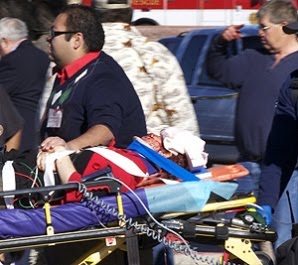 According to the Arizona Republic, Hernandez was standing about 30 feet from Giffords during the "Congress on Your Corner" event outside a Safeway store near Tucson. When the gunshots began, Hernandez ran toward them and began checking the pulses of people who'd been hit. When Hernandez got to Giffords, he used his hand to apply pressure to the entry wound on her forehead. He pulled her into his lap and held her upright so she wouldn't choke on her blood. Hernandez, who confirmed that he is gay in an interview with Instant Tea , is a member of the City of Tucson Commission on Gay, Lesbian, Bisexual and Transgender Issues. "She's been a great ally to the LGBT community," Hernandez said of Giffords during the brief interview.
[{(o)}]|[{(o)}]|[{(o)}]|[{(o)}]| [{(o)}]|[{(o)}] |
